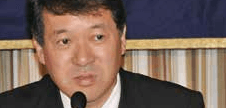Issue:
Time to fire up the reactors? “Not so fast,” says Niigata governor Hirohiko Izumida
ANYONE INCLINED TO GIVE Japan’s “Nuclear Village” the benefit of the doubt, to assume that nuclear regulators and plant operators have fully digested the lessons of Fukushima Daiichi, would do well to watch the FCCJ video of Hirohiko Izumida, governor of Niigata. It may change your mind.
Izumida, 52, an LDPer and former METI bureaucrat, told the FCCJ audience on Oct. 15 how the July 16, 2007 earthquake in his own Niigata Prefecture informed his perspective on nuclear safety. Its epicenter was beneath the seabed, 19.6 kilometers offshore from Tepco’s Kashiwazaki Kariwa complex, with seven reactors the world’s largest nuclear power plant. The plant was Izumida’s problem from the moment the 6.6 magnitude quake struck at 10:13 a.m.

Japan’s 47 governors are the frontline generals of the nation’s disaster response system. Disaster plans are laid on a prefectural basis, and governors assume broad executive powers once a disaster is declared. An equally severe quake having hit the area just three years earlier, Niigata officials were well familiar with their quake response handbooks and the existence of a hotline to the Kashiwazaki Kariwa plant. But when they called, no one answered.
As officials later learned from Tepco, the door to the room with the hotline had been warped by the quake, so no one could get in to pick up the phone. So as reports of black smoke rising from Kashiwazaki Kariwa came in to officials in Niigata City, the prefectural capital 66 kilometers to the northeast, they were understandably alarmed by their inability to reach the plant’s management. “We had to rely on television news reports,”Izumida said.
It turned out that severe subsidence caused land in parts of the site to drop 1.5 meters, rupturing pipes containing cables and thereby causing the fire. As water mains also ruptured, dry hydrants left firefighters to stand by and watch it burn.
In the aftermath, prefectural officials tore a strip off Tepco and demanded a number of specific modifications to the plant.
“As direct communication with the site is essential in the event of disaster,” Izumida said, “we strongly asked Tepco to install a special facility where communication could be assured, a ‘seismic isolated building’ impervious to shaking. Under regulations at the time this was not required, but due to our bitter experience we demanded it be built. Still, Tepco tried to get around this, asking if it wouldn’t be okay just to use mobile phones. But we were adamant.”
Consequently, a similar facility was completed at Fukushima Daiichi just eight months before 3/11. “If we hadn’t demanded this, it’s unlikely one would have been built at Fukushima,” Izumida noted. “And if that had not been built it’s unlikely that people would be living in Tokyo today.”
“You have to ask if Tepco should even have the right to operate a nuclear reactor.”
The upgraded firefighting capability Niigata demanded was also copied at Fukushima, which Izumida credited with firefighters there having the alternative means to pour cooling water on the reactors.
Noting that Japan’s Nuclear Regulatory Authority (NRA) is making new standards for nuclear plants, Izumida expressed “grave concerns” about the process: “Given that the Fukushima accident has not yet been fully reviewed, bringing in new regulatory standards is very unwise. What worries us is that the NRA seems to be trying to shrink its responsibilities. They have a broad mandate to ensure the safety of nuclear power, but Chairman Shunichi Tanaka seems to be focusing on small technical details instead of pursuing the full scope of measures recommended by the IAEA.
Emphasizing prefectural governments’ broad responsibility for disaster response, Izumida complained “the NRA refuses to even listen to our concerns. They refuse to communicate with us, so we have to put our ideas across in the public consultation process. Even then, our comments are not being taken into account.”
Izumida bluntly pointed to Tanaka as the heart of the problem, citing his reluctance to meet with local officials or even the president of Tepco. “His thinking is not about how to respond if an accident occurs… but rather how to evade responsibility. As a professor of nuclear science he seems to have decided to focus solely on technical matters. He is not thinking about the more important mission to protect the lives and assets of the people.”
Tanaka’s contention that Japan’s nuclear regulations are the strictest in the world was not credible, said Izumida. But if he was scathing in his criticism of Tanaka, his comments on Tepco were scorching.
“Tepco understood from a very early point that a meltdown had occurred, yet they hid this fact for over two months,” Izumida said. “So you have to ask if they should even have the right to operate a nuclear reactor. We need to have a complete assessment of the Fukushima accident and where responsibilities lie. Until that is done we cannot even begin to discuss restarting plants.”
When asked why he alone was speaking out so stridently, Izumida noted that he was advocating a position agreed by the association of Japanese governors, then added darkly that even people close to him worried about what might happen to him for speaking out.
Scathing and scorching though his comments were, Izumida delivered them with an impressively cool composure, backed by a wealth of cogently argued technical detail. Watch the video and you may well decide that reactor restarts should only come if and when Izumida says it’s time.
John R. Harris is a speechwriter and freelance journalist based in Onjuku on Chiba’s Pacific coast.

